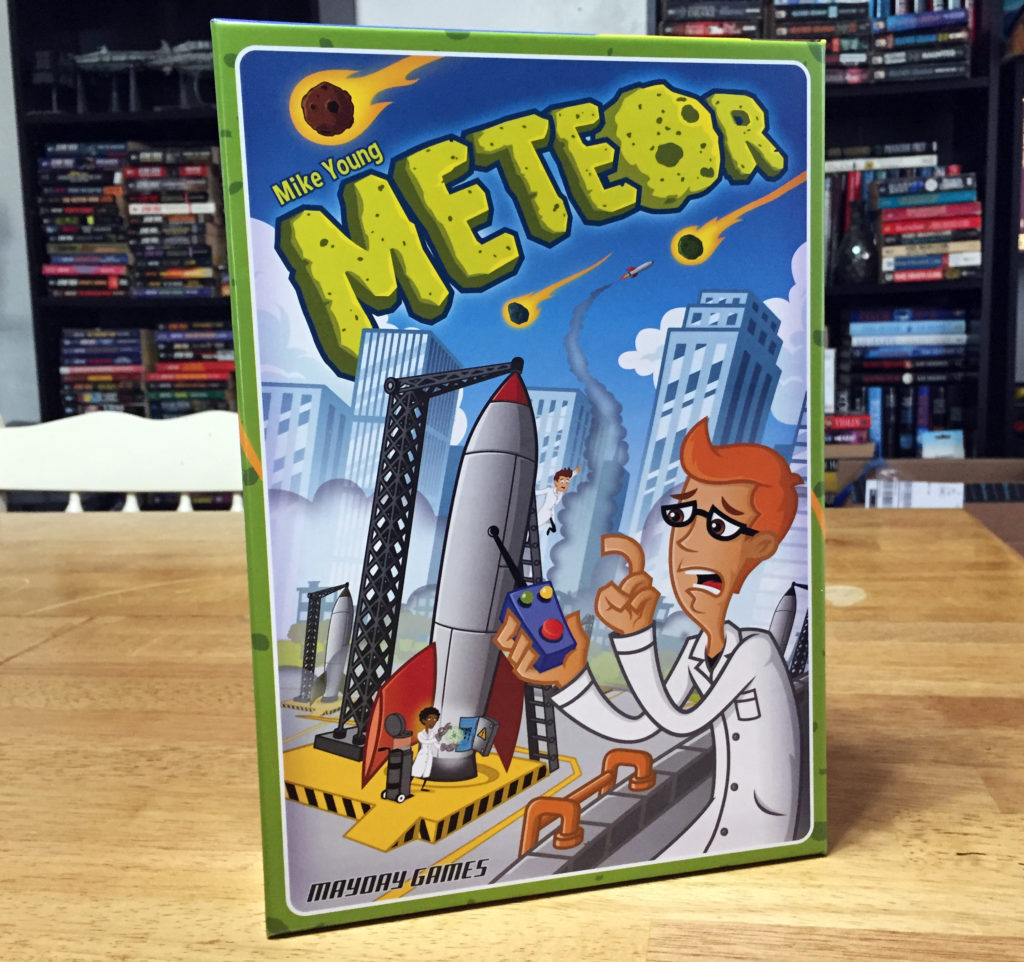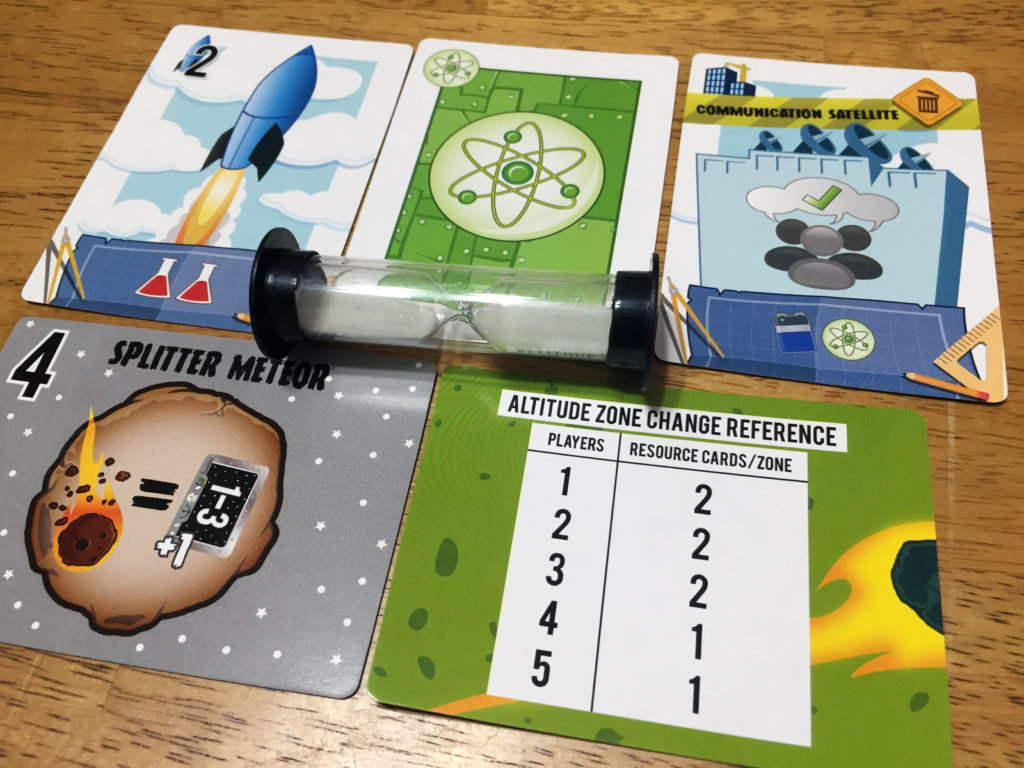Five minutes. Five minutes are all you have to save the planet from a meteor storm the likes of our kind has never seen. What’s worse, Bruce Willis is nowhere in sight. All you have are your quick wits and the brains of those around you, with your ultimate goal being to collectively launch enough rockets to blow the giant rocks from space. Before we start mixing the rocket fuel and singeing our eyebrows, I’d like to thank the folks at Mayday Games for providing me with a press copy for review purposes.

Meteor: 1-5 Players, Ages 13+, Average Play Times = 5 Minutes
Components
The game includes 5 altitude zone cards, 39 energy cards, 31 rocket cards, 6 technology cards, 26 standard meteor cards, 10 boss meteor cards, 13 power cards, 11 challenge cards, 5 retrofit reference/launch site leader cards, 1 set up card, and five one-minute sand timers. The boss meteor, power, and challenge cards are only used for the advanced game. To keep this review moving, I’ll opt to exclude them from the next section.
Editor’s Note: The 2.0 version I received was the “regular game/big box”. The 2.0 mini box version has no sand timers and contains fewer cards, but retails for less.
Setup & Gameplay
The 26 standard meteor cards are shuffled together to form a meteor deck, with a number being placed face down according to the setup chart in the manual. New players may opt to deal them face-up to see their exact size and traits. In either case, players may “meteor mulligan” if they don’t like the values they see. The altitude cards are placed in a stack in descending order (5 on top) and the timer is placed nearby. Each player gets a site leader card, along with a number of resource cards (based on the number of players) to form their hand. There are no player turns and thus, no starting player.
The object of the game is for players to collectively destroy all of the meteors within five minutes. To do that, players will need to build and launch rockets via launch sites. Launch sites can only accommodate one project at a time (rocket, tech, or retrofit), though they can discard an unfinished project to make room for a new one. Players can only have one rocket individually (unless they’re going for a retrofit), but can queue them up and launch them as a team for the purposes of increasing their attack strength against a single target (or to attack different targets). In addition to using launch sites to build rockets, players can acquire technology and complete sets of rocket or energy cards to draw more resource cards to add to their hands (retrofit). Each project requires a specific set/combination of cards to complete.
When a rocket is launched, the player will pick a target meteor which is then flipped to see its strength. When the damage done by the rocket is equal to the meteor’s strength, it is destroyed. If it’s less, then the rocket has no effect. If it’s greater, then the meteor is destroyed but an overkill occurs. An overkill causes the remaining meteors to move on altitude zone closer to Earth, ending that round immediately.
While players are building and completing projects, one player (known as the timekeeper) will be managing the timers and altitude cards. Essentially, each altitude card is allotted one minute. The game starts with starting a one-minute timer for altitude five. When the one minute runs out, each player draws new resource cards (based on the number of players) and the next altitude number is revealed (with the next one-minute timer being flipped when ready). There’s also no talking until the “communications satellite” tech has been built, though you can start the game with it for an easier time.
The game ends in failure when five minutes are up and there are still meteors in play. Alternatively, if all players destroy the meteors (an overkill on the last meteor at altitude one is OK) before time limit expires, then they’ll win!
Editor’s Note: The above doesn’t cover all of the rules found in the manual, but should give you an idea as to how the game is played.

The Review
I normally don’t like playing timed games because I’m the sort of person that HATES to be rushed. I’m old dammit! Despite this preference, I really enjoyed playing this one. Being able to pause the game whenever you feel like it by putting the timer on hold may sound like cheating to some, but it’s possible for those of you in the same boat as me who just need to slow things down to catch their bearings. If you’re going to do that, my advice is to only do so when you’re looking up rule clarifications as the game is really meant to be played with a ticking clock. The timer adds a sense of tension that you wouldn’t feel otherwise without it. If you find the game to be too rough, you can do two-minute rounds to give yourselves more time to talk strategy.
It can be especially challenging to work together if you opt not to start with the communications satellite already researched as it allows players to communicate with one another. In fact the game recommends you start with this tech your first few times out to make the game a bit easier…I couldn’t agree more. Without verbal communication, you’re reduced to pointing and being much more observant with your eyes. While adding an extra layer of difficulty, not having the communications satellite in the beginning certainly makes things even more interesting. Flipping the meteors face-up during setup is another way to make things easier.
Besides the cooperative aspect, there’s a bit of strategy involved. For example, you don’t know the strength of a particular asteroid until you fire a rocket at it. Will you save up and use your heavy hitters so that you can knock it out on the first try? Or will you forgo the risk of an overkill (which ends the round immediately) and hit it with a weak rocket in order to reveal its strength value? Perhaps you feel that your teammates are fine building the rockets themselves, so concentrating on researching tech and/or allowing the team to draw more cards might be more beneficial. All of these thoughts, dilemmas, and strategies need to be resolved in pretty short order though, so the ability to think quickly on your feet will serve you well here.
As a cooperative experience, “Meteor” delivers. It encourages players to talk things out (when they can) and make snap decisions that could determine success or failure. While the play time is indeed quick (the box says five minutes), it’s more realistic to set aside about twenty minutes to account for set up and clean up. When you tire of the basic game (I doubt I ever will), there are boss meteors, power cards, and challenge cards available to make the game more interesting. If you feel that the price tag is fair and within your budget ($35 for the big box, $25 for the mini box), then you should totally grab this one…especially if you play cooperative games like “Pandemic” on a regular basis. It’s just so darned customizable to suit any level of difficulty you choose, which is a big plus in my book.
Final Verdict: 8/10
—
